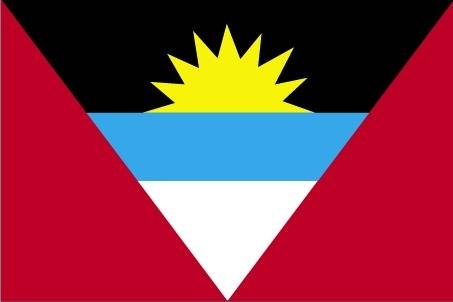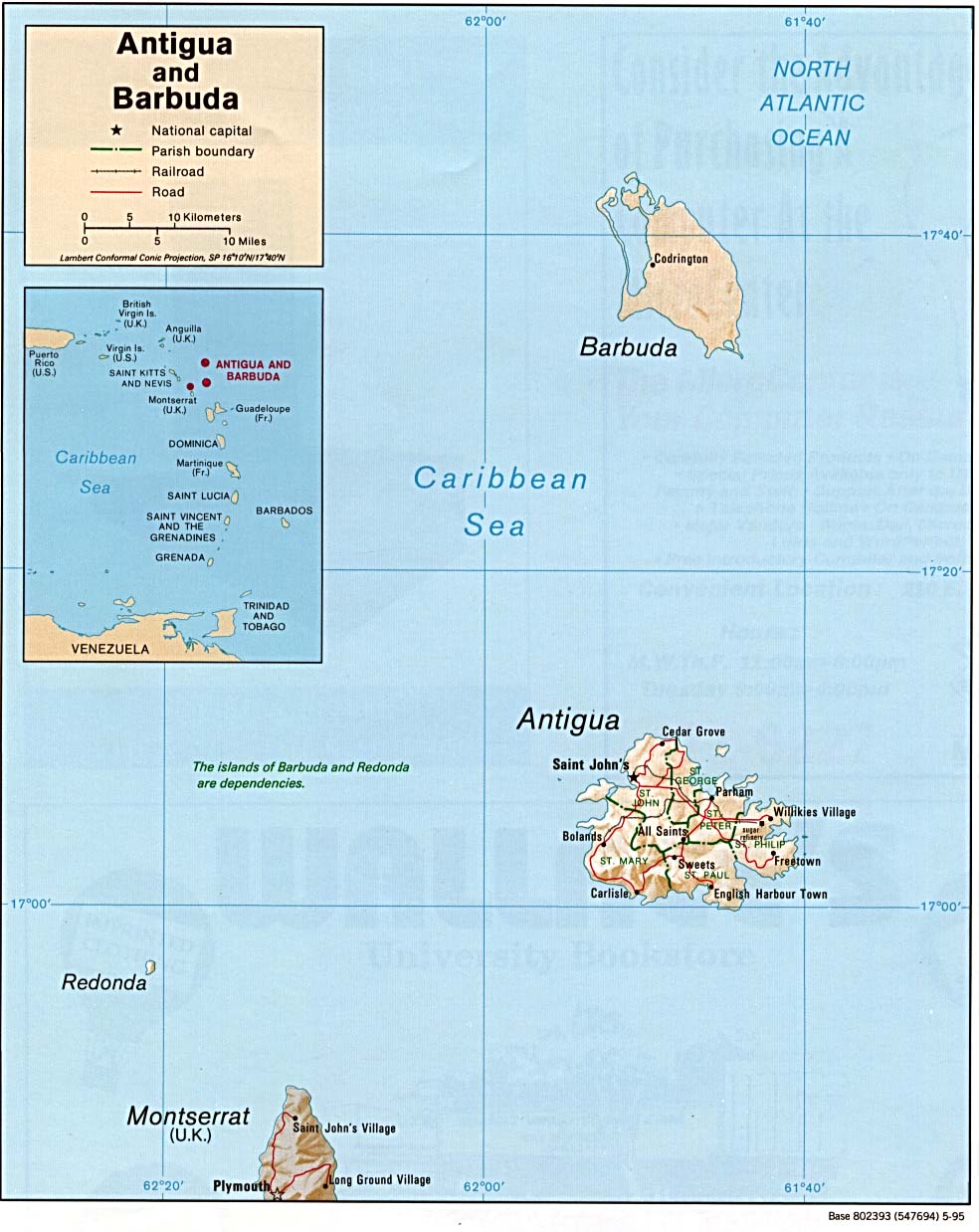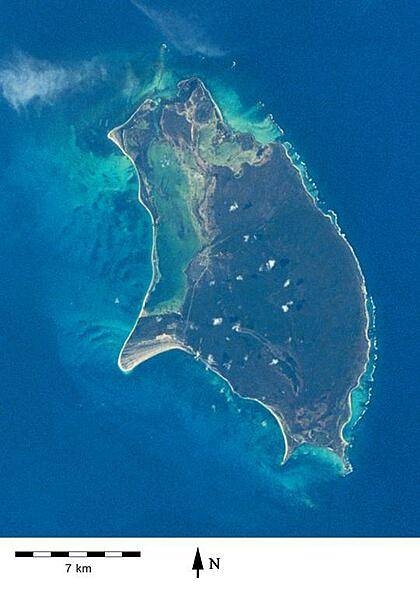3 Antigua and Barbuda

Red, with an inverted isosceles triangle based on the top edge of the flag. The triangle contains 3 horizontal bands of black (top), light blue, and white, with a yellow rising sun in the black band. The sun symbolizes the dawn of a new era, black represents the African heritage of most of the population, blue is for hope, and red is for the dynamism of the people. The “V” stands for victory. The successive yellow, blue, and white coloring is also meant to evoke the country’s tourist attractions of sun, sea, and sand.
Flag courtesy of the CIA World Factbook

 A closer view of the island of Antigua shows severely eroded volcanic remnants along its forested southwestern quadrant.
A closer view of the island of Antigua shows severely eroded volcanic remnants along its forested southwestern quadrant.
Photo courtesy of the CIA World Factbook
 Barbuda as viewed from space. The island, which lies north of Antigua, is mostly coral limestone and exhibits little topographic variation; its highest point is only 38 meters above sea level. Barbuda is sparsely inhabited compared to its sister island.
Barbuda as viewed from space. The island, which lies north of Antigua, is mostly coral limestone and exhibits little topographic variation; its highest point is only 38 meters above sea level. Barbuda is sparsely inhabited compared to its sister island.
Photo courtesy of the CIA World Factbook
Government
According to Britannica, Antigua and Barbuda is a constitutional monarchy with a parliamentary form of government. The British monarch is nominal head of state, represented by a governor-general. The constitution allows for a two-chamber legislature, consisting of a Senate and a House of Representatives. Executive power is vested in a Council of Ministers headed by the prime minister, who is the head of government.
Ministry of Tourism, Civil Aviation, Transportation, and Investment
Ministry of Tourism, Civil Aviation, Transportation & Investment
Organization of Eastern Caribbean States (OECS)
The Organization of Eastern Caribbean States (OECS) is an eleven-member grouping of islands spread across the Eastern Caribbean. Together, they form a near-continuous archipelago across the eastern reaches of the Caribbean Sea. They comprise the Leeward Islands: Antigua and Barbuda, Saint Kitts and Nevis, Montserrat, Anguilla, and the British Virgin Islands; and the Windward Islands: Dominica, Saint Lucia, Saint Vincent and the Grenadines and Grenada, Martinique and Guadeloupe.
Eastern Caribbean Civil Aviation Authority (ECCAA)
The Eastern Caribbean Civil Aviation Authority (ECCAA) evolved from the Directorate of Civil Aviation – Eastern Caribbean States, which may be considered as one of the oldest, if not the oldest institutions in the Eastern Caribbean region. From inception, the Directorate was seen as a vehicle for facilitating a collective and uniform approach to Civil Aviation matters affecting the then Windward and Leeward Islands, which now comprise the OECS Group.
Airspace
SkyVector – Google Maps – ADS-B Exchange
ICAO countries publish an Aeronautical Information Publication (AIP). This document is divided into three parts: General (GEN), En Route (ENR) and Aerodromes (AD). ENR 1.4 details the types of airspace classes they chose to adopt from classes A through G.
Air Navigation Services are provided by the Government of Antigua and Barbuda through the Ministry of Public Utilities, Civil Aviation, Transportation and Energy (The ANSP). The departments which provide air navigation service on behalf of the Government are the Antigua and Barbuda Air Traffic Services and Antigua and Barbuda Meteorological Services.
The Antigua and Barbuda Airport Authority (ABAA) is a statutory body which falls under this Ministry. It was established by an Act of Parliament in November 2006. The mandate of this Statutory body was stated as “to provide for the establishment of an Airport Authority; to make provisions for the ownership, control, management and development of airports in Antigua and Barbuda; and for matters connected generally with management of airports”.
The Authority provides supporting services such as Aerodrome development and maintenance for the V. C. Bird International Airport on Antigua and the Codrington Airport located on Barbuda.
Drone Regulations
Guidance for Operation of Drones and Model Airplanes in Antigua and Barbuda
Advanced Air Mobility (AAM) Regulations & Policies
None found by the author.
However, should you, the reader, happen to stumble across something to the contrary, please email the author at FISHE5CA@erau.edu and you may be mentioned in the ACKNOWLEDGEMENTS section of this book by way of thanks for contributing to this free eBook!
Advanced Air Mobility (AAM) News
None found by the author.
However, should you, the reader, happen to stumble across something to the contrary, please email the author at FISHE5CA@erau.edu and you may be mentioned in the ACKNOWLEDGEMENTS section of this book by way of thanks for contributing to this free eBook!
Short Essay Questions
Scenario-Based Question
You have been hired by a Drone Startup Company. Your boss has immediately assigned this job to you.
They need you to prepare a one-page memo detailing the legalities of using a drone at the Codrington Airport on Barbuda, pictured above.
They need you to mention any national laws and local ordinances.
They specifically want to know what airspace (insert pictures) you will be operating in, and whether or not you need an airspace authorization.
Does it matter whether or not you are a citizen of the country?
Lastly, there is a bonus for you if, as you scroll through this chapter, you find any typos or broken links!
Short Essay Questions
- What are the drone categories?
- How is registration addressed?
- How is remote ID addressed?
- What are the model aircraft rules?
- What are the commercial drone rules?
- Are there waivers or exemptions to the rules? If so, for what?
- Would you share a link to an interactive airspace map?
- How is BVLOS addressed?
- How can you fly drones at night?
- How can you fly drones over people?
- Where do you find drone NOTAMs?
- What are the rules for drone maintenance?
- What are the rules for an SMS program?
- What are some unique rules not mentioned above?
- What are the C-UAS rules?
- What are the AAM rules?

